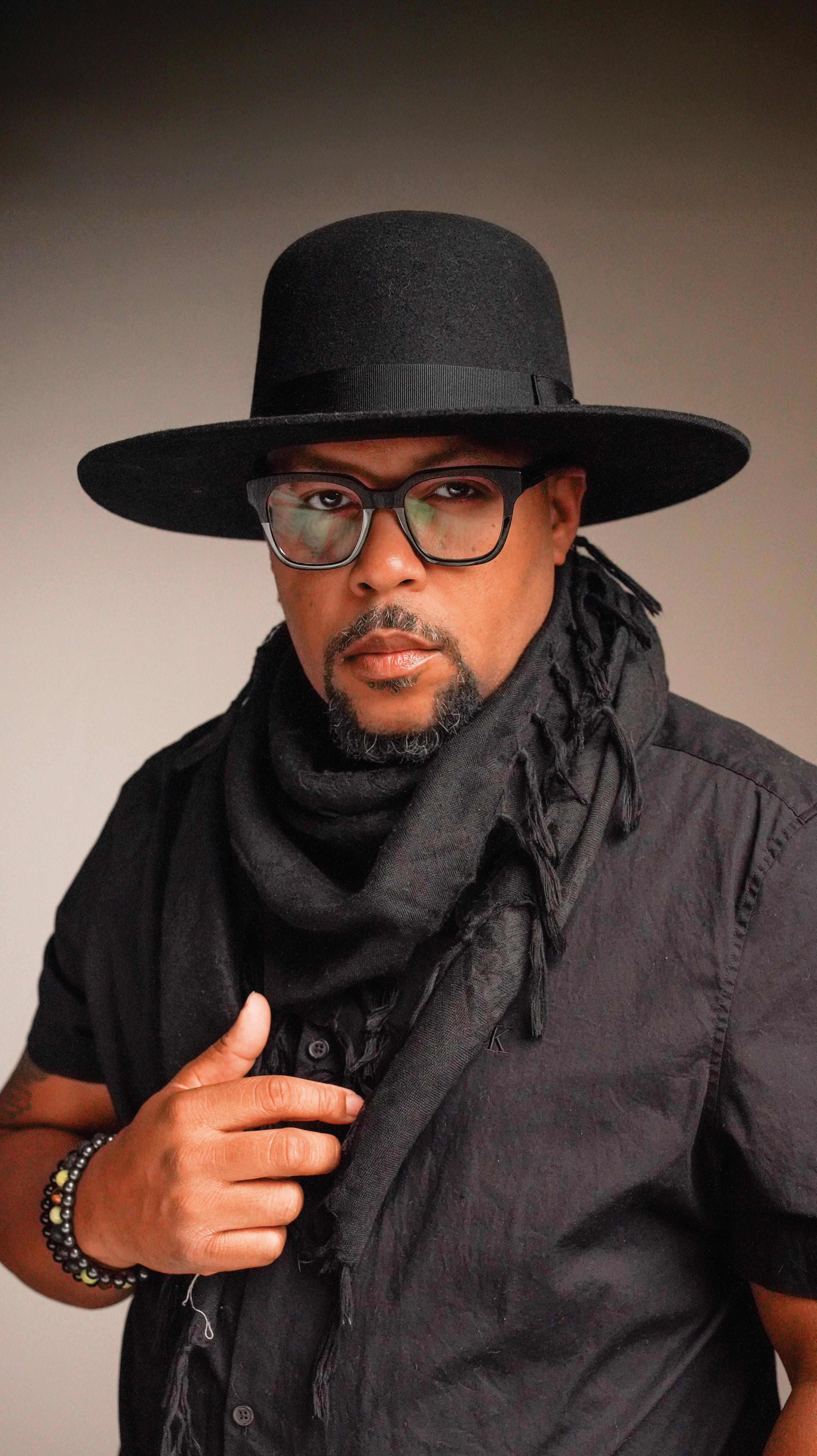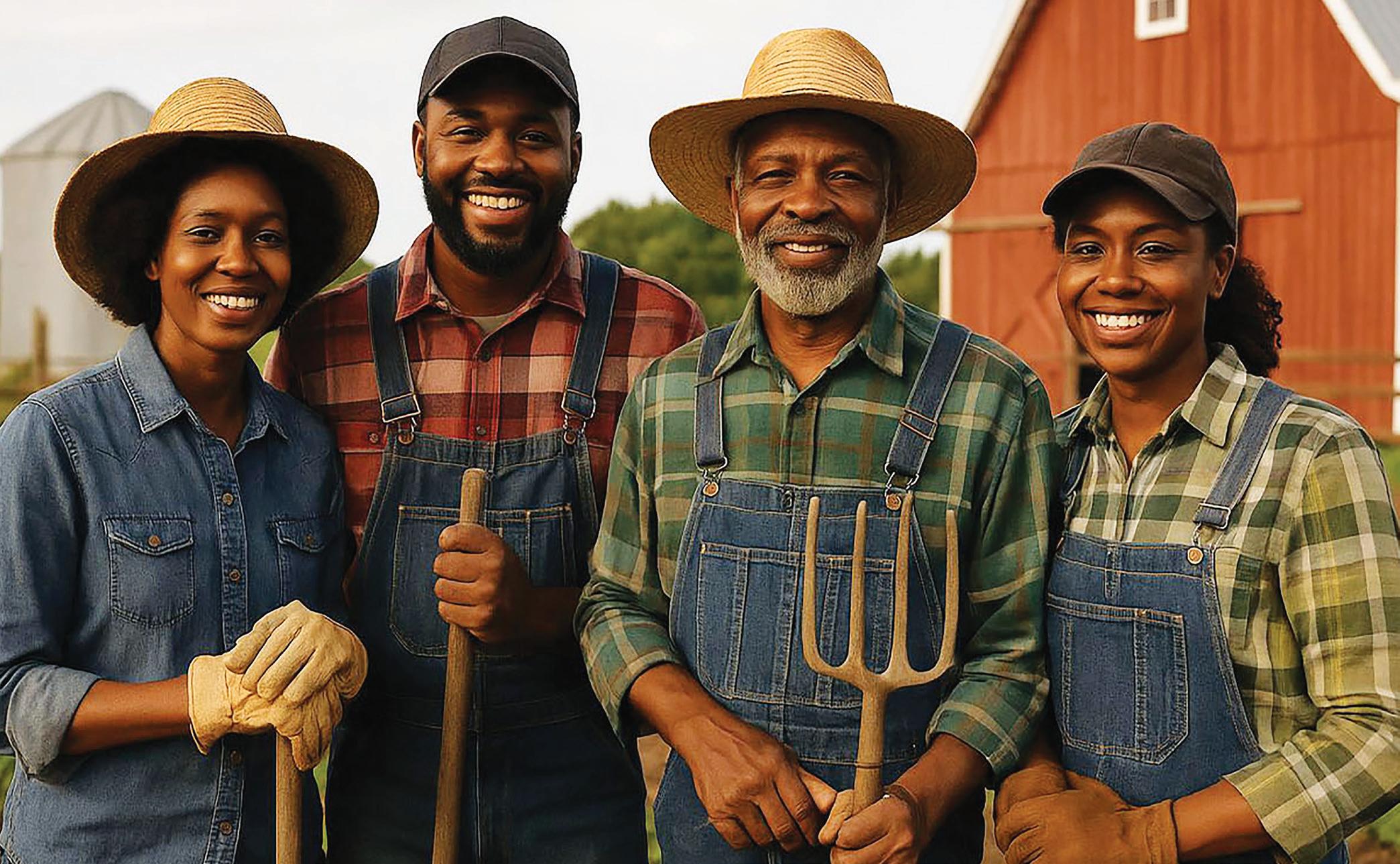












































By Stacy M. Brown Black Press USA Senior National Correspondent
Democratic Congressman David Scott of Georgia has introduced legislation aimed at safeguarding the future of Black farmers and reversing decades of systemic discrimination. As the Trump administration moves to eliminate key diversity, equity, and inclusion (DEI) protections at the U.S. Department of Agriculture, Democratic Congressman David Scott of Georgia has introduced legislation aimed at safeguarding the future of Black farmers and reversing decades of systemic discrimination.
On July 17, Scott, a senior member of the House Agriculture Committee, introduced the Black Farmers and Socially Disadvantaged Farmers Increased Market Share Act of 2025. Illinois Democratic Congressman Jonathan Jackson, also a member of the committee, co-sponsored the bill, which aims to expand market access and enforce civil rights protections for farmers who have historically been denied equitable treatment by the federal government. “Generations of Black farmers have lost their land and livelihoods because of systemic discrimination and the federal government’s failures to meaningfully intervene,” Scott said. “Whereas they comprised over 14% of all U.S. farmers
less than a century ago, they now represent less than 2%.” In 1920, there were nearly one million Black farmers in the United States. But today, fewer than 50,000 remain, Jackson said. “That’s a staggering 95% decline. This did not happen by accident — it is the result of broken policies, discriminatory lending practices, and a lack of market access,” he stated. The bill establishes a competitive grant program to support new and expanding food hubs that enable Black and minority farmers to access wholesale, retail, and institutional markets. It offers a 25% tax credit for agricultural products purchased from those food hubs. It also requires the USDA to prioritize procurement from
socially disadvantaged farmers and establishes an independent Office of the Civil Rights Ombudsperson to assist farmers through civil rights claims. Additionally, the measure reforms USDA policies to provide monetary relief to farmers denied access to loan and payment programs due to discrimination. The bill’s release follows a sweeping policy reversal by the USDA, which recently announced it will no longer use the term “socially disadvantaged” to define farmers affected by racial, ethnic, or gender-based discrimination. That designation, first adopted in the 1990 Farm Bill, had been a
“This is more than a symbolic gesture, it is a strategic and spiritual alignment.” When the Black Church and Black Media speak as one, we can ignite a movement. When we organize as one, we can shift the narrative. When we act as one, we cannot be ignored or denied,” the coalition stated.
Nashville, TN — July 25, 2025: In a historic announcement, a coalition of leading Black faith organizations and the National Newspaper Publishers Association (NNPA) unveiled a strategic partnership and plan to confront systemic disparities impacting African American communities nationwide.
“There is strength in unity. There is power in our collective voice. There is hope in our actions”
- Dr. Boise Kimber -
Dr. Boise Kimber, President of the National Baptist Convention, USA, Inc.; Bishop J. Drew Sheard, Presiding Bishop of the Church of God in Christ (COGIC); Dr. Samuel Tolbert, President of the National Baptist Convention of America; and Dr. Benjamin F. Chavis Jr., veteran civil rights leader and President of the NNPA, are leading this collaboration between the Black church and Black Media.

For generations, African American communities have endured deep-rooted inequities in healthcare, education, criminal justice, economic op-
Due process: What it means in US law and its implications for migrant rights
By April Ryan Black Press USA
not just raise deep concerns that the government of King George III was violating the Colonists’ rights, which they described in the declaration. They would also enshrine these principles in the U.S. Constitution over a decade later through the concept of “due process.” What did the framers likely mean when they did so? That’s no longer simply an academic question for legal scholars like me. The meaning and application of due process has become a crucial issue in the


portunity, and access to capital. These challenges are not new.
U.S., most often with respect to the Trump administration’s migrant deportation efforts. Over the past several months, the U.S. Supreme Court has made several rulings in deportation-related cases with respect to what’s called the due process clause of the Constitution. In April 2025, in the case Trump v. J.G.G., the court seemed to state quite clearly that deportations could not

Trump admin accuses Obama admin of ‘knowingly lying’ in intelligence assessment of 2017 Russian collusion in U.S. election
By April Ryan Black Press USA Washington, DC Bureau Chief
and White House Correspondent
A packed White House briefing room of reporters heard the Director of National Intelligence, Tulsi Gabbard, lay out her claim against former President Barack Obama and his top officials. Gabbard offered that the nation’s first Black president worked to subvert a Trump 2016 presidential win with claims that Russia negatively
impacted that presidential election, almost 10 years ago. Even though Donald Trump defeated his opponent Hillary Clinton, Gabbard told reporters that Obama and his National Intelligence officials “knowingly lied” in their 2017 intelligence assessment of Russian election collusion. During Gabbard’s speech to the press, familiar names were dropped on the mic like Hillary Clinton, who Gabbard alleged was on “tranquil-
Officials work to unravel how and why gunman carried out deadly attack on NYC office building

Jennifer Peltz, Cedar Attanasio, Dave Collins and John Seewer, Associated Press
NEW YORK (AP) — Investigators on Wednesday were looking into how a former high school football player who blamed the game for his mental health problems carried out a deadly attack on an office building that is home to the NFL. Shane Tamura, 27, killed four people on Monday before killing himself, spraying the skyscraper’s lobby with bullets and then continuing his rampage on the 33rd floor, authorities said. In a handwritten note found in his wallet after the attack, Tamura claimed he had chronic traumatic encephalopathy, known at CTE, and accused the NFL of hiding the dangers of brain injuries linked to contact sports, investigators said.

By Stacy M. Brown Black Press USA Senior National Correspondent
A new report from the Prison Policy Initiative reveals how President Donald Trump’s administration is driving mass deportation by secretly using local jails—even in places with sanctuary policies—to detain immigrants. The report, Hiding in Plain Sight: How Local Jails Obscure and Facilitate Mass Deportation Under Trump, de-

tails how these local facilities, through contracts with the U.S. Marshals Service, have become a critical infrastructure in Trump’s deportation strategy. Building on the organization’s previous work explaining how county jails enable state and federal incarceration, this latest analysis breaks down the overlap between local criminal justice systems and federal immigration enforcement. The report also provides extensive

Minnesota is not just a place. It is a story. And like all stories, what gets remembered depends on who gets to tell it.
When I made my way to Strive Bookstore for the signing of The Black Lawyer in Minnesota: 1973–2023 by attorney Jeffrey Hassan, I wasn’t entirely sure what to expect. I knew it would be a celebration.
I assumed it would be meaningful. But I wasn’t prepared for the feeling that would wash over me as I stepped through the door and looked around the room.
It was filled with Black legal history makers. Judges, attorneys, elected officials, trailblazers. People who had fought for justice in courtrooms, communities, and institutions that were never designed with them in mind. I was suddenly aware of how powerful this moment was. How rare it is

to be in the presence of so much wisdom and legacy, all in one space, all still shaping the world around them.
And the space mattered. Strive is more than a bookstore. It is a sacred space that centers Black narratives and honors the different voices and perspectives that exist within the African Diaspora. It is a place built to help us heal, teach, learn, and leave a legacy. Hosting this event there wasn’t just fitting. It was necessary. It ensured that this history was not just preserved, but uplifted in a space committed to the full
complexity of our truth. This was not just a book launch. It was a restoration. Too often, history is flattened. Reduced to timelines, headlines, and names on plaques. Even Black excellence, when acknowledged, is frequently stripped of its full context. But what Attorney Hassan has done is insist on dimension. On truth. On memory. He has preserved a collective narrative that would otherwise be at risk of distortion or erasure.
Because we know how this works. We know
whose stories are recorded and whose are forgotten. We know who gets remembered as a founder and who gets dismissed as a footnote. Black legal history, especially here in Minnesota, is rarely given the fullness it deserves.
This book interrupts that cycle. It captures the stories of the lawyers, judges, and community leaders who transformed Minnesota’s legal landscape. The ones who opened firms when no doors were open
to them. The ones who defended our communities in moments of deep injustice. The ones who brought lawsuits, passed legislation, mentored others, and built institutions. They didn’t just practice law. They changed what the law could be.
It was humbling to listen to them speak. To hear not only what they fought for, but how they carried the weight of being first, of being only, of knowing that every step forward had to matter for more than just themselves.
And it reminded me that storytelling is not soft work. It is structural. The stories we choose to preserve shape the systems we build. They define what justice looks like. They tell us who belongs. And if we don’t protect our stories, we leave space for others to revise them. As a young Black woman and Gen Z attorney, I often feel the urgency of this moment. We are living through a time when truth is under attack. When memory is politicized. When progress is treated like a threat. We are being told that our stories must be quiet, narrow, and palatable. That is why this night mattered. Why this book matters.
It refuses to be quiet. It refuses to forget. It refuses to shrink. Minnesota is still being written. And thanks to Attorney Hassan, the chapters that have too often been left in the margins are now placed squarely at the center. The challenge now is to keep writing. To make sure the story of justice in this state reflects all who have shaped it and all who will. Because Minnesota is a story we tell. And we have only just begun.
could get another tax break. The consequences of this bill will be felt for years to come and we are already seeing the consequences play out across the country.
Donald Trump and Republicans in Congress have pushed through their big, ugly bill, making the largest cuts to health care in American history. They slashed more than $1 trillion from Medicaid and the Affordable Care Act (ACA) and took away tax credits that make health care more affordable for middle-class Americans. The bill will strip health care from more than 15 million people, increase costs on middle- and low-income families, and send shockwaves through middleand working-class families trying to make ends meet, all so billionaires and big companies
As lawmakers head home for August recess, the time to talk about the GOP war on health care is now. We must broaden the successful narrative around Medicaid to include the millions of people who will see their premiums skyrocket or lose their ACA coverage altogether as a result of this bill.
As Republicans are forced to explain their vote for this bill to their constituents and continue to lie about the health care cuts, accountability is our most important mission.
Democratic lawmakers must make sure every American knows who took away their health care and raised their costs
and premiums in order to give tax breaks to the wealthy. When parents can’t take their children to the doctor, when rural hospitals shut their doors, when cancer patients lose their coverage mid-treatment, it can only trace back to one thing: Donald Trump and Congressional Republicans did this to fund tax breaks for the ultra-rich. The Republican megabill hikes premiums this fall and takes coverage away from people starting this winter. Hospitals and nursing homes around the country are already cutting back or closing their doors as a result of the GOP bill. A hospital in Nebraska is shutting down because of this Republican attack on health care. Hundreds more hospitals, clinics, pediatric and maternity units, and nursing homes
are expected to cut services or close their doors entirely as a result of this bill. Reports from around the country demonstrate the harm the Republicans’ bill is already doing to critical care facilities, and the crisis is only going to get worse. Democrats have a winning hand to play on health care. Polling shows that the American people overwhelmingly disapprove of Republicans’ massive health care cuts. Six in 10 disapprove of the GOP’s megabill and think that it will raise their health care costs, and a majority think it will do more to help the wealthy while harming middle- and low-income people. In fact, 55 percent of voters say they would not support someone who voted to cut Medicaid. We are winning the messaging war and Repub-
licans are running scared, introducing new bills to roll back policies they just voted for. The Full Timeline of Consequences:
2025
Medicaid cuts begin: With the passage of the Big Ugly Bill on July 4, Donald Trump and Republicans ended Biden-era rules which made enrolling in Medicaid easier for seniors, kids, and people with disabilities. Additionally, the bill immediately placed a prohibition on Medicaid funding for Planned Parenthood and a moratorium on new sources of other critical funding for states. ACA rollback begins: Trump and the Republicans eliminated tax credits which make health care more affordable as part of their Big
Ugly Bill. As a result, insurance companies finalizing their rates for 2026 right now are locking in drastic Affordable Care Act (ACA) premium hikes. A new analysis from KFF showed that base premium rates are already increasing by an average of 15 percent, with even greater premium hikes to come in the Fall for consumers losing their tax credits. At the end of August, the Trump administration will impose new rules on ACA coverage, making it harder to access health care. The new rules shorten the period during which Americans can enroll in coverage and impose new red tape designed to worsen coverage and kick people off the rolls. As a result, millions lose their health care as soon as next year.
2026





GOP premium hikes take effect: Starting on January 1, 24 million Americans who buy insurance on their own will see their premiums skyrocket, including small business owners, farmers, and people with pre-existing conditions. Ripping these tax credits away from middle-class families will force them to pay 75 percent more on average. Some families could pay nearly twice as much for their health care, and millions will lose their coverage altogether because they can’t absorb Republicans’ cost increases. At the same time, new rules will take effect that make it easier for insurers to rip consumers off by charging people more for lower quality plans and making it harder for families to enroll in affordable, high-quality coverage. Medicaid cuts hit the states: CMS will establish guidance for red tape requirements designed to throw people off their coverage by forcing working families to reapply for Medicaid every 6 months. States like Texas that have implemented similarly frequent eligibility checks have seen dras-



When Roosevelt Mansfield speaks about his exhibit My Living Legends of Rondo, his voice doesn’t carry the tone of an artist merely discussing work. It carries reverence and an emotional register that makes it clear: this project is about legacy, gratitude, and memory.
Aired on KFAI
90.3FM’s popular radio show
The Conversation with Al McFarlane, the segment drew listeners into the heart of the Rondo community through Mansfield’s lens. Literally.
“The whole idea came from a dark place,” Mansfield admitted. “COVID almost took me out. I was in really bad shape. I started thinking about all the people who got me here, who saved me, who showed up
when my parents couldn’t. And I just knew I needed to give them their flowers while they could still smell them.”
The result is My Living Legends of Rondo, a photography exhibit that debuted at 825 Arts, the newly named community arts hub in St. Paul’s Rondo neighborhood. The collection features striking portraits of elders, coaches, activists, and unsung heroes who helped shape generations, many of whom never sought the spotlight.
Coach Ronnie Smith is among them. In one photograph, Coach Ronnie is captured in a pose that radiates strength and quiet resolve. Mansfield shared the backstory. “When I was a teen, my family was living in shelters. Coach sold me
basketball shoes for $20. Not gave, sold. That small transaction gave me pride. I wasn’t getting a handout. I earned it. That kept my dignity intact.”
He went on to describe how Smith prepared neighborhood boys for big games, not in the gym, but on the blacktop. “He’d invite us to scrimmage with older players. Every move, he’d coach us. We didn’t even know he was training us for competition. That’s the kind of intentional care he gave us.”
Another photo features educator and mentor Floyd Smaller, seated beside a 1936 radio. The moment was spontaneous. “He was telling someone how he and his brothers used to ‘watch TV through the radio.’ That memory? How sound
painted the pictures for them? I had to capture that,” Mansfield said. “That’s history in motion. It’s storytelling in the body.” These aren’t polished studio shots. They’re atmospheric, textural, layered. And that’s the point. “I’m selftaught. I learned to draw from JC Penney catalogs and the Sunday comics. But I stopped because I was teased for drawing dresses and hairstyles,” he said. “Years later, my daughters played volleyball. I bought a camera to capture their games, and I realized I could still show people what I see, even if I can’t always explain it.”
Mansfield was the DJ at the “Choice of Weapons” exhibit featuring works Gordon Parks and Jamel Shabazz. Roosevelt introduced himself,

showed photos and his vision. That vision earned him a mentorship with world-renowned photographer Jamel Shabazz. “Now he’s guiding me, helping me understand the publishing world, exhibition circuits. I just got back from

Photoville in New York,” Mansfield said.
With My Living Legends, Mansfield is already turning heads locally. His exhibit “US” is showing at 804 Artists Lofts in Minneapolis. His large-scale image from the “Its The People” project is now displayed behind the Orpheum Theatre in downtown Minneapolis along Hennepin Avenue.
“My Living Legends of Rondo - Giving Flowers” exhibit is on display at Halle Q Brown Community Center in the heart of Rondo “We’re not just documenting history but we’re placing it where people can’t ignore it,” he said.
Note: The “My Living Legends of Rondo” exhibit was first showcased at 825 Arts during Rondo Days 2024 and is part of a broader initiative to preserve Black legacy in St. Paul. The conversation originally aired on KFAI’s “The Conversation with Al McFarlane.” Explore the full conversation with Roosevelt Mansfield and Ms. Mercedes on The Conversation with Al McFarlane, originally aired on KFAI 90.3FM. Hear their voices, see their passion, and witness how Rondo’s story continues through art and memory. Watch here: https:// www.youtube.com/watch?v=JDBUH82a6TM&t=7s Or scan the QR code below to view directly on YouTube:

Mizz Mercedes, community organizer and director at 825 Arts, called the exhibit “transformational.” She noted how many of the featured elders still play vital roles in young people’s lives. “Mr. Mansfield featured folks who mentored him, but they’re also coaching our kids today. It’s generational continuity,” she said. “That’s what Rondo is.” For Mansfield, the message is clear. “Photography is life. It’s how we shape perception. If we don’t define our story, someone else will. And they’ll get it wrong.” At a time when murals have been painted over and history risks being forgotten, My Living Legends of Rondo reclaims the narrative, with dignity, clarity, and love.
By Pulane Choane Contributing Writer
The pulse of the Rondo community beat strong in a powerful episode of The Conversation with Al McFarlane, aired on KFAI 90.3FM, where elders and new-generation leaders came together to reflect on Rondo’s living legacy, community power, and the critical need for healing and historical preservation.
As Rondo Days approached, this conversation became more than just a preview of an event. It became a collective declaration of identity, truth, and self-determination.
“We’re not memorializing anything,” said Gayle Smaller, board chair of Rondo Avenue Inc. “Memorials are for things that are dead. Rondo is not dead.”
This sentiment set the tone for the dialogue, which featured his father Floyd Smaller, founder of Rondo Days and community elder; Kedar Hickman, an officer at the St. Paul Foundation; Mikeya Griffin, executive director of the Rondo Community Land Trust; and host Al McFarlane, a longtime voice of the Black press in Minnesota. Together, they spoke on legacy, displacement, and the active work of preserving and rebuilding what remains.
“The spirit of Rondo is what you’re doing right

now,” Floyd Smaller said to McFarlane. “It’s people opening up and finding the true truth of Rondo. Our neighborhood housed and protected us, taught us what school could not, and gave us the space to grow.”
Smaller described Rondo as a living classroom and a family unit. Even those society overlooked played critical roles in guiding the youth. He shared how his activism came at great personal cost, balancing his roles as a coach, teacher, and advocate while raising a family.
“What I did for Rondo was not easy,” he said. “I sacrificed my family, myself, and a whole lot of people for that.”
He reflected on the loss of Rondo’s name during the destruction brought by highway construction and the deep
spiritual victory of restoring it. “When they take your street, it’s like taking your shoes and coat off your back. They are telling you that you no longer count.”
Kedar Hickman emphasized that despite the physical destruction of Rondo, the people endured. “There’s this narrative that the road destroyed us,” he said. “But I look around and see five people who are not destroyed, who are not broken. A new generation built on Selby. We kept our culture and our businesses.”
For Hickman, the work ahead includes not only continuing to build institutions
but also expanding what is possible. He challenged the community to dream of a regional Black college or innovation space and called for the creation of a lasting community endowment. “We are the foundation. Let’s build on that truth.”
Mikeya Griffin brought this vision into reality through the work of the Rondo Community Land Trust.
“When I took over, I inherited a 28-year-old startup,” she said. “We stabilized, and now we reimagine. This is about reclaiming space for the community and holding assets in trust for the people who built Rondo.”
By Pulane Choane Contributing Writer
“Love is power,” said Mizz Mercedez—and for anyone who’s watched her work in the Rondo community, it’s clear she lives by those words.
Appearing on The Conversation with Al McFarlane on KFAI 90.3FM ahead of Rondo Days 2025, Mizz Mercedez didn’t just reflect on her heritage—she reaffirmed her mission: preserving Rondo’s past while shaping its future. As the Community Engagement Director of 825 Arts, she serves as both steward and storyteller, ensuring that the neighborhood’s legacy remains rooted in the hands of its people.
“We were a community’s dream,” she said, recalling how the historic building at 825 University Avenue was
saved from demolition.
Fifteen years ago, the installation of the light rail at University and Victoria sparked resistance among Rondo-Frogtown residents. At the time, Model Cities planned to purchase and demolish the building to create a parking lot. But the community stood up.
“The community members said, ‘No, this is a hundred-year-old building. We want an art center.’”
Through that collective resistance, the building was preserved and ultimately designated a historic landmark. Still, no funding followed. “So for the past 15 years, we’ve been raising money,” she said. “And finally, last year on August 25— 8/25—we had our grand opening.”
Formerly known as the Victoria Theater Arts Center, the renaming to 825 Arts was a purposeful act of cultural
reclamation.
“Queen Victoria was not a reflection of our community. That name came from colonialism and racism—that’s not us,” she explained.
Extensive community engagement followed. Suggestions like “Rondo Arts Center” and “Frondo” (a blend of Frogtown and Rondo) were proposed. But after three months of input, one name rose to the top. “825 Arts is what won,” she said. “And I loved it—because the community is diversifying.”
The new name wasn’t just symbolic; it was transformative.
“A lot of other cultures don’t even realize their everyday practices are art—because to them, it’s just culture,” she said. “But now, under 825 Arts, we’re saying: ‘No. What you’re doing is art.’ We showcase art 825 different ways.
Which means everything.”
Since opening, the center has hosted events like Roosevelt Mansfield’s Living Legends of Rondo exhibit—testament to the vision Mercedez and her community fought for.
“I’m very intentional about making sure that this building is where the community’s dreams come true.”
For her, the mission is personal. She lives on Central Ave., the same block her great-grandmother, Durie Mae Yarbrough, once lived.
“Her house was where people who migrated came for food, shelter, to get their hair done… She was a caregiver. And now, to be doing this work on the same block—it means everything to me.”
Mercedez is determined that artists from her community not only be seen, but respected.
Under Griffin’s leadership, the trust has supported homeownership, protected local businesses, and designated part of Selby Avenue as the Rondo African American Arts and Cultural District. She explained that land trusts originated from the struggle of the civil rights movement. “People forget that community land trusts came out of our suffering. This is about economic mobility for Black people. In perpetuity.”
Gayle Smaller spoke with deep emotion, acknowledging those who helped revive Rondo Days in recent years. He praised Mikeya for stepping in when others hesitated, offering funds to keep the event going. “You gave us the mission to continue building something that could be extraordinary. I honor you for that.”
The conversation unfolded as a testimony to Black resilience and community care.
Floyd Smaller, a respected elder, was surrounded by people who had been mentored by him and were continuing the work in their own ways. “We were raised to protect each other,” he said. “And if you don’t love your community, you can’t sacrifice for it.”
McFarlane reminded listeners of the broader meaning of the conversation. “We must keep the memory of who we are, whose we are, and where we are going. Our work is to be

the authors of a future in which we win.”
The broadcast closed with an invitation for the broader public to attend Rondo Days and to reflect on what community means beyond a single day of celebration. The street may have been torn apart, but the spirit has not been extinguished. From land ownership and cultural events to youth mentorship and political advocacy, the people of Rondo continue to write a new chapter grounded in legacy and forward motion.
Note: This conversation aired prior to the 2025 Rondo Days celebration on KFAI 90.3FM’s The Conversation with Al McFarlane, as part of the “Healing Circle” series. Rondo Days took place on Saturday, July 19, 2025, at Martin Luther King Park in St. Paul, Minnesota.
To watch the full conversation and explore more stories from Rondo Days, visit: www.insightnews. com/rondo2025
Scan the QR code below to watch the full episode from The Conversation with Al McFarlane.

highlight us in the program, but they don’t support us how we need to be supported.”
Looking forward, her vision remains grounded in legacy, youth, and imagination. Whether it’s her Rondo-based comic books or youth-centered programs, the goal is clear: make history something young people can feel and live.
“I want kids to read the book and know they can experience it in real life,” she said. “You are the author of your life. You get to write what happens next. Just like I wrote this book—and now I’m making it real—you can too.”
As Rondo continues to evolve, Mizz Mercedez is making sure its spirit doesn’t fade with time.
“Too often we get invited into spaces, our work gets used, but our voices don’t. They
“Once I realized love is power—it changed everything,” she said. “Just show love. Love your community. Love your neighbor. Love your family. And it’ll bring power to whatever you’re doing.”
By Pulane Choane Contributing Writer
In the lead-up to Rondo Days 2025, a powerful and deeply personal conversation unfolded on Radio KFAI’s The Conversation with Al McFarlane. The broadcast, which aired just before the July 19 event, featured organizers Merina Neal and Nick Muhammad. Together, they explored the meaning behind Rondo Days, unpacked its legacy, and reflected on the long arc of Black resistance and renewal in St. Paul’s historic Rondo community.
Wednesdays on McFarlane’s show are typically devoted to themes of entrepreneurship, community wealth, and collective advancement. That particular episode focused on Rondo not just as a festival but as a mirror of what the Black community has endured and what it continues to build.
“Rondo is historic in many, many ways,” McFarlane said as he opened the segment.
“And I think the finest example of a space for this conversation is in the work of the Rondo community in St. Paul.”
For Merina Neal, the conversation was not merely logistical; it was personal. She described herself as a “Rondo transplant baby” with roots running deep in the community. “I’m from a legacy family of Rondo that is off of Carroll and Fisk,” she said. “The actual commemorative plaza is right behind our family houses. I’m a Neal and proud to be part of
the Neal family. So, this touches really close to home for me.”
Neal’s contributions to the festival went far beyond public-facing roles. “I’ve had the honor to do the admin stuff behind the scenes,” she explained. “Making sure we are staying on track as far as food vendors and table vendors and making sure everybody has their credentials and licenses.
It’s a small but mighty team, and we’ve been working since last year to make sure everything happens.”
Rondo Days is widely recognized as one of the most significant, Black-led cultural festivals in Minnesota. It commemorates a community that was systematically displaced in the mid-20th century through the construction of Interstate 94. The disruption destroyed over 600 Black-owned homes and more than 300 Blackowned businesses. For Nick Muhammad, who also joined McFarlane’s broadcast, the festival serves as an ongoing act of remembrance and resistance.
“The short version is that there was a historic community district on Rondo Avenue,” he said. “And the city of St. Paul and the state of Minnesota decided to allow the interstate to come through and disrupt that entire corridor, displacing all of that intellectual, economic, and social capital.”
Yet Rondo Days is not only about what was lost; it is also about what endures.
“The beauty of legacy for me is that the community allowed me to come in and essentially adopted
me and my family,” Muhammad said. Originally from Indianola, Mississippi, which is the birthplace of blues legend B.B. King, he said Rondo reminded him of home. “It was the first space in Minnesota that made me feel like I was back home. You could go to Mr. Tilman’s Market or Earth’s Beauty Supply and see Black-owned businesses in real time, owned by families that lived right here in the neighborhood.”
Throughout the interview, both Neal and Muhammad emphasized that Rondo Days exists because of love and labor, not funding or recognition. “There’s no money when you do events,” Neal said frankly. “It has always been about community and exposing the Caribbean community and the African American community and what we celebrate - food, music, culture, religion.”
McFarlane affirmed that message and asked what culture meant to Neal, particularly in the context of raising children within the Rondo neighborhood. “For me, community is love. One love,” she answered. “Whether I’m representing my Caribbean community or my Rondo community, I eat, breathe, and live our Black communities. I reinvest my hard-earned money within the Rondo community every single day.”
Muhammad, who handled city permits and logistics, brought a similar passion to the table. “I’m basically stuck on all the paperwork. Me and Trinny C (Neal)… dotting I’s

and crossing T’s,” he said. Despite the bureaucratic challenges, his motivation was clear. “This is really bigger than us. It’s about what happened before us and what’s going to happen when we’re gone.”
The conversation also traced the psychological and spiritual weight of displacement. McFarlane spoke of his own memories visiting Sunflower, Mississippi, where his grandmother lived in a shotgun house with gaps in the floorboards and geese that poked their heads through to nip at his toes. “That’s how close we are to it,” he said, reflecting on how his great-grandmother had been born into slavery. “People will tell us we should get over it. We can’t.”
Muhammad responded with a story of his own, recalling his great-aunt who was sold for a cow and how that legacy shaped his mother’s choice to name her daughter Amy. “To know those stories is kind of
incredible,” he said. “I just remember my great-grandmother in my grandfather’s house. Every morning, he had to chop wood at 4 a.m. to keep the house warm.”
The interview shifted again toward the importance of memory. “Our elders are walking universities,” Muhammad said. “And a lot of us don’t want to go to school. We ignore them until we become the elders ourselves and realize we didn’t listen. Then it comes full circle.”
As the program came to a close, McFarlane asked Muhammad what he saw for the future. His response was clear and urgent. “I would encourage people to tap into their confidence in the legacy of family. Particularly Black family. Don’t underestimate the power of yourself. Don’t let anybody tell you what you can and can’t do.” He added, “The geographic place isn’t necessarily
where the power comes from. It’s the people who made the place up, and that hasn’t gone anywhere.”
The Rondo Days conversation offered more than a preview of a festival. It was a love letter to a community, a tribute to its elders, and a declaration that legacy is not only remembered but lived. Through story, laughter, and reverence, the broadcast reminded listeners that Rondo is not an echo of the past. It is a living, breathing commitment to a future built in our own names. Watch the full conversation on Insight News’ YouTube channel:

By Pulane Choane Contributing Writer
A new musical offering by the Grammy Award-winning Sounds of Blackness, a group long known for their soul-stirring fusion of gospel, R&B, hiphop, and pan-African rhythms, declares that We’re Unstoppable.
The new single premiered last month, embodies the spirit of cultural resistance, intergenerational legacy, and Black creative power. “It’s a musical statement of cultural and spiritual resistance,” said Gary D. Hines, longtime music director of Sounds of Blackness. “Resistance to the rising tide of DEI rollbacks, cultural erasure, and all the other mess that’s going on in our country and world.”
The track features vocals by Jamecia Bennett, the dynamic young group NunnAbove, and percussion by the Atlanta Drum Academy. Hines emphasized that the release was intentional in both message and timing. “This is not a coincidence,” he said. “It’s right after Rondo Days. It’s a national and international declaration that we are unstoppable as a people, culturally, musically, and spiritually.”
While the song draws from tradition, its purpose is rooted in the present. Hines said the recording was a deliberate response to national shifts, including the dismantling of Diversity, Equity, and Inclusion (DEI) programs in schools and public institutions. The song, he explained, is both a counter-nar-

rative and a tool for teaching youth about their identity and purpose. “We’ve got to let our young people know, number one, that they have a role to play in this whole process. Number two, they’re not alone. And number three, that they stand on the shoulders of giants of culture-bearers, of warriors, of truth-tellers, of griots.”
For Hines, that message was deeply personal. He reflected on an international moment that shaped his view of cultural unity, attending Panafest in Ghana years ago, where Sounds of Blackness performed with Stevie Wonder. He recalled meeting Al McFarlane who was arriving to Ghana at the airport in Accra. “We shared a moment,” Hines said. “It reminded me that this work is global. The message of our music, our struggle, and our hope, none of it stops at city borders.”
Gayle Smaller, a lifelong Twin Cities resident and Rondo Days organizer, shared how the legacy of Rondo lives on, not just in events, but in val-
ues passed through generations.
“Rondo’s not dead,” she said.
“We’re still living it. It’s not just about having a parade or a festival. It’s about saying, ‘This is who we are.’ It’s about our grandkids knowing they come
how music and memory go hand in hand. Songs like We’re Unstoppable offer more than entertainment and that they are in fact cultural artifacts, meant to keep ancestral stories alive. “I think this is what my father and my uncles were talking about. We’re hearing that beat that comes from the village. We’re hearing that beat that comes from the continent. We’re hearing the call to action.”
Rondo Days, launched in 1982, commemorates the historically Black neighborhood of Rondo, which was severely disrupted in the 1950s and 1960s when Interstate 94 was constructed through its heart. Each year, the celebration becomes a living monument to what was lost, and what continues to rise.
Lord Jamar, a hip-hop artist and cultural commentator best known as a founding mem-

from something.”
Smaller emphasized

stage as the national headliner during the Rondo Days festivities. Speaking on The Conversation, he recounted how the group’s name was a conscious act of self-definition. “I started studying African history and spirituality. I kept seeing the word ‘Nubian’ in my studies … Dr. York, the Five Percent Nation, all of it. And I thought, ‘That’s it. That’s who we are.’
Our brand is Nubian.” For Jamar, naming is not just semantics but rather, it’s a spiritual and political declaration. “The name tells people what you stand for before you even open your mouth.”
The energy around We’re Unstoppable marks more than a musical release. It’s part of a larger movement that insists on presence, truth, and intergenerational memory. “We’re not just making music,” Hines said. “We’re mentoring. We’re modeling. We’re letting them know, you have a place in this legacy. And we want them to pass it on.”
ber of Brand Nubian, took the

drummers, this anthem is a reminder that cultural memory is alive, rhythmic, and determined. “We’re unstoppable,” Hines affirmed. “That’s not just a song title. That’s who we are.” Listen now: “We’re Unstoppable” by Sounds of Blackness: https://music. youtube.com/watch?v=HcA3PV6OPME
Watch the full interview and live broadcast: https://www.youtube.com/ watch?v=paf6OVonpLA
Or scan the QR code below to view the full interview between Al McFarlane, Gary D. Hines, Gail Smaller and Lord Jamar:

From St. Paul to Ghana, from the elders of Rondo to the voices of Atlanta youth


critical foundation for programs that served Black, Hispanic, Native American, and Asian producers. According to Capital B News, the agency’s decision came in response to executive orders issued earlier this year by President Donald Trump that eliminated any mandates or programs supporting DEI. The USDA stated that it has “sufficiently” addressed its history of discrimination and that moving forward, it will adhere to a raceand gender-neutral framework.
Unite
From 3
The coalition intends to put an end to fragmented responses and speak with one clear, concise and consolidated voice.
Lloyd Wright, a Virginia farmer and former USDA official, stated that the change will disproportionately affect Black farmers. “They’re eliminating socially disadvantaged and anything else dealing with DEI,” Wright told Capital B. “[The government] is going to take back the money — the little bit we were getting—and some of the outreach money will be clawed back.” Rep. Shontel Brown of Ohio, a vice-ranking member on the House Agriculture Committee, added that the USDA’s decision was part of “Trump’s resegregation agenda.” She called the rule “a delib-
erate and disgraceful step backward,” and said the “socially disadvantaged” label was long overdue recognition of the systemic denial of land, credit, and opportunity. Rep. Shomari Figures of Alabama said the administration should be working to ensure Black farmers are never subjected to such discrimination again, not reversing policies that acknowledged that history. Tiffany Bellfield ElAmin, founder of the Kentucky Black Farmers Association, noted that while the label itself may have had flaws, its removal leaves Black farmers more vulnerable. She said Black pro-
ducers are often left to navigate USDA programs without the same outreach given to white farmers, and that many with large operations were never disadvantaged to begin with. The USDA’s move comes in response to pressure from white farmers and conservative legal groups. A Wisconsin farmer, Adam Faust, has sued the administration, claiming he faced reverse discrimination in multiple USDA programs. Faust previously led a successful lawsuit against the Biden administration in 2021, halting a $4 billion loan forgiveness program aimed at aiding farmers of color.
Black farmers continue to challenge federal agencies in court. The Black Farmers and Agriculturalists Association recently sued the USDA for allegedly excluding them from the Discrimination Financial Assistance Program, which provided help to over 43,000 farmers who suffered discrimination before 2021. Senator Raphael Warnock of Georgia said the administration’s actions amount to political theater. “Instead of working to create more certainty for our nation’s farmers and adopting a stable trade agenda, this administration is focused on divisive publicity stunts that
will hurt our agriculture industry long-term,” he said. Scott’s bill builds on years of advocacy, including his efforts to expose that just 0.1% of a $26 billion USDA pandemic relief package went to Black farmers. As Farm Bill reauthorization talks continue in Congress, Scott said this moment must be used to embed equity into agricultural policy. “Congress has a responsibility to reverse the decades of inaction by restoring trust, creating new market opportunities, and ensuring USDA supports our Black and socially disadvantaged farmers,” Scott said.
The Black Church and Black Media, two institutions that have long anchored and uplifted Black America, are now coming together with renewed focus and purpose. This partnership is grounded in shared values, spiritual conviction, cultural empowerment, and an unwavering commitment to truth, justice, and progress.
From 3
take place without due process.
More recently, however, in D.H.S. v. D.V.D., the Supreme Court prevented a lower court from providing due process protections to a group of men the administration wanted to deport to South Sudan, where they are at risk of facing torture and even death.
These seemingly contradictory rulings not only make it unclear when due process applies but probably leave many asking what the term “due process of law” even means and how it works.
The origins of due process
The American concept of due process can be traced from medieval England to its modern formulation by the U.S. Supreme Court. Doing so allows the meaning of due pro-
From 3
izers daily.”
During the briefing, several warnings were issued from the podium over this latest Trump administration controversy. Gabbard, wearing all white before the press, concluded her statement by saying,
From 3
Detectives on Wednesday were digging into the Las Vegas casino worker’s background and motivations. They planned to question a man who supplied gun parts for the AR-15-style rifle used in the attack, including the weapon’s lower receiver, Police Commissioner Jessica Tisch said in a video statement.
Among the dead were a police officer, a security guard and two people who worked at companies in the building. An NFL employee was badly wounded but survived. Tamura, a surveillance worker for the Horseshoe Las Vegas, had meant to target the NFL’s headquarters in the building but took the wrong ele-
From 3
Building on the organization’s previous work explaining how county jails enable state and federal incarceration, this latest analysis breaks down the overlap between local criminal justice systems and federal immigration enforcement. The report also provides extensive data tables showing the level of involvement in every state and in over 600 specific jails.
“The Trump administration is circumventing city and county sanctuary policies that limit cooperation with federal immigra-
The coalition will focus on five core initiatives: Shaping a unified na-
cess to come into focus. It also calls into question the court’s most recent ruling on this issue.
The concepts of due process and the rule of law largely emerged in the 13th century in the Magna Carta, a formal, written agreement between King John of England and the rebel aristocracy that effectively established legal constraints on government.
One key passage from the Magna Carta provided that “No Freeman shall be taken, or any otherwise imprisoned, or be disseised of his Freehold, or Liberties, or free Customs, or be outlawed, or exiled, or destroyed; nor we will not pass upon him, nor condemn him, but by lawful Judgment of his Peers, or by the Law of the Land.”
This accord established formal constraints on a previously unrestrained regent, setting English law on the course that would prioritize rule of law over the whims of the monarch.
“The implications of this are far-reaching and have to do with the integrity of our Democratic republic.”
President Obama refuted the allegations this week through a press representative, calling it “ridiculous.” However, Gabbard says, “It has to do with an outgoing president, taking action to manufacture intelligence to undermine” Donald Trump.
vator, authorities said. It’s unclear whether he showed symptoms of CTE, which can be diagnosed only by examining a brain after death.
Tamura, who played high school football in California a decade ago but never played in the NFL, had a history of mental illness, police said without giving details. In the three-page note found on his body, he accused the NFL of concealing the dangers to players’ brains for profit. The degenerative brain disease has been linked to concussions and other repeated head trauma common in contact sports such as football.
At a Tuesday night vigil for those killed in the shooting, Muslim, Sikh, Buddhist, Hindu, Christian and other faith leaders delivered prayers at a park about a dozen blocks from where the shooting took place.
tion authorities,” the report said. “It accomplishes this through a longstanding loophole: ICE and other federal agencies can refer people for federal prosecution on immigration-related ‘crimes’ and thus use local jails’ contracts with the U.S. Marshals Service in sanctuary cities, counties, and states.” This strategy, according to the report, turns civil immigration matters into criminal cases, thereby allowing the federal government to detain people in local jails even where sanctuary laws are on the books. As a result, local communities are unknowingly participating in federal deportation efforts.
The report also makes
tional narrative that challenges harmful stereotypes and amplifies stories of Black resilience, excellence, and innovation
Mobilizing faith-based and media networks to address community disparities through solutions-focused advocacy and outreach
Holding corporate
America accountable by demanding responsible reinvest-
Over a century later, Parliament would pass the English statute of 1354 that said “That no Man of what Estate or Condition that he be, shall he put out of Land or Tenement, nor taken nor imprisoned, nor disinherited, nor put to death, without being brought in Answer by due Process of the Law.”
These principlesd evolve over time in British law and then informed the emerging revolutionary spirit in the American Colonies.
Released in January 1776, Thomas Paine’s pamphlet Common Sense would help galvanize and steel many Colonists for the revolutionary conflict to come. The work shifted the focus of Colonists’ anger from trying to force the king to treat them better to more radical change: independence and a country governed by the rule of law.
What the Colonists wanted, Paine wrote, was not a monarch: “So far as we approve
White House press
Secretary Karoline Leavitt weighed in several times during Gabbard’s question and answer period with the White House press. The 27-year-old Leavitt said, “While publicly pretending to engage in a peaceful transfer of power, in private, former President Obama went to great and nefarious lengths to…sabotage his successor President Trump.”
Mayor Eric Adams and Gov. Kathy Hochul spoke of the need for stronger gun laws.
“We cannot respond to senseless gun laws through vigils,” Adams said.
NFL boss calls shooting ‘unspeakable’
Tamura’s note repeatedly said he was sorry and asked that his brain be studied for CTE.
The NFL long denied the link between football and CTE, but it acknowledged the connection in 2016 testimony before Congress and has paid more than $1.4 billion to retired players to settle concussion-related claims.
NFL Commissioner Roger Goodell, who works out of the offices, called the shooting “an unspeakable act of violence.”
The shooting happened at a skyscraper on Park
clear that ICE’s official numbers don’t reflect the full scale of immigrant detention in the United States. While ICE reported an average daily population of 57,200 in June 2025, the actual count—including people facing immigration-related criminal charges, those held on ICE detainers, and individuals confined in state-run facilities or overnight hold rooms—reaches approximately 83,400, a 45 percent increase over ICE’s published figures. “Many cities and states have tried to offer sanctuary for immigrants by refusing to rent jail space to ICE and opting out of the 287(g) program, but it is not enough,” said Jacob Kang-Brown, author of
ment in Black communities through sustainable partnerships, economic equity, and community-led development
Empowering the next generation by reclaiming our narratives and creating new pathways for education, leadership, and entrepreneurship
Holding elected officials accountable by spotlighting those whose policies do not
of monarchy, that in America THE LAW IS KING. For as in absolute governments the King is law, so in free countries the law ought to be King; and there ought to be no other.”
Defining due process
After independence, many of the original 13 states adopted their own constitutions that would enshrine principles akin to due process to protect their constituents from government overreach, such as that government was to be bound, as it was in Virginia’s Declaration of Rights in 1776, by “the law of the land.”
But it was not until the nation adopted the Bill of Rights – the first 10 amendments to the Constitution – in 1791 that the federal government could not act in a way that deprived the populace of life, liberty or property without due process of law. After the Civil War, the 14th Amendment would apply these same protections to all government action, state and federal.
Leavitt went as far as to chastise the press, particularly those who won awards for reporting on the Obama Russian intelligence report. Speaking for the administration,, Leavitt said those winning journalists must be “stripped” of their awards.
And when asked if Friday’s Obama report from the DNI was to help heal her relationship with President Trump, Leavitt said, “The only people
Avenue, one of the nation’s most recognized streets, just blocks from Grand Central Terminal and Rockefeller Center. It is less than a 15-minute walk from where UnitedHealthcare
CEO Brian Thompson was shot and killed last December by a man who prosecutors say was angry over what he saw as corporate greed.
Video shows the gunman stroll into the building Tamura drove across the country in the days before the attack and into New York City, Tisch said. Surveillance video showed him exit his BMW outside the building at about 6:30 p.m. Monday wearing a button-down shirt and jacket with the rifle at his side. Once inside the lobby, he opened fire and killed Islam and Wesley LePatner, a real estate executive at the investment firm Blackstone, which occupies much of the building. Ta-
the report. “The Trump administration is leveraging jails at a new scale, using local contracts with the U.S. Marshals Service and existing policing practices in order to expand detention.” Since Trump’s return to office in January, 45 percent of all ICE arrests have occurred in jails. The report explains how ICE capitalizes on local arrests, often for minor offenses that wouldn’t result in jail time for U.S. citizens, such as driving without a license, to target immigrants. These arrests, the report notes, create a misleading appearance that ICE is focused on serious criminal activity, when in fact most detainees have little or no crim-
align with the interests of the Black community. To earn our votes, they must heed our voices.
“This is more than a symbolic gesture; it is a strategic and spiritual alignment.”
When the Black Church and Black Media speak as one, we can ignite a movement. When we organize as one, we can shift the narrative. When we act as one, we cannot be ignored or denied,” the coalition stated. The coalition invites all stakeholders, faith leaders, media professionals, community organizers, educators, business leaders, and concerned citizens to join this movement for unity, justice, and progress.
The contemporary and most comprehensive formulation of what due process requires can be found in the Supreme Court’s ruling in the 1970 case Goldberg v. Kelly, brought by welfare recipients challenging their loss of such benefits without a hearing. In that case, the court determined that when governments attempt to deprive someone of their life, liberty or property, the target of those attempts must receive fair notice of the charges or claims against them that would justify that loss; be given an opportunity to defend against those claims; and possess the right to have such defenses considered by an impartial adjudicator.
The Supreme Court in 1976 would accept that due process protections in different settings will vary based on a number of variables. Those include what is at stake in the case, the likelihood that government might make a mistake in a particular setting, and the
who are suggesting that the Director of National Intelligence would release evidence to try to boost her standing with the President are the people in this room who constantly try to sow distrust and chaos amongst the President’s cabinet, and it is not working.” Leavitt said, “He [President Trump] has the utmost confidence in Director
mura then made his way toward the elevator bank, shooting the NFL employee and an unarmed security guard, Aland Etienne, who helped control access to the upper floors.
Tamura waited for the next elevator to arrive in the lobby, let a woman walk safely out of the elevator, then rode it up to the 33rd-floor offices of the company that owns the building, Rudin Management. He killed a worker for that company before killing himself, officials said.
Friends and family
mourn killed officer
Officer Didarul Islam, 36, who was guarding the building on a paid security job when he was killed, had served as a police officer in New York City for over three years. He was an immigrant from Bangladesh and was working a department-approved building security job when he was shot.
inal history. The report offers reporters and advocates access to detailed data that shows how many people are held for ICE and the U.S. Marshals in hundreds of facilities, including the change in these populations over time. It includes the share of detained immigrants in each state held by local jails, the rates of ICE arrests occurring in jails compared to other locations, and the growing number of immigrants arrested by the U.S. Marshals on charges related to immigration status. The report also includes information on per-diem payments made by the U.S. Marshals to local jails in exchange for housing federal detainees.
benefits and burdens of providing certain forms of process in a given situation.
When someone’s life is literally on the line, for example, more exacting procedures are required. At the same time, regardless of how important the interest that is subject to due process – whether it is one’s life, one’s home, one’s liberty, or something else – the components of fair notice, an opportunity to be heard, and to have one’s case decided by an impartial adjudicator must be meaningful.
As the court said in Mullane vs. Central Hanover Bank & Trust Co. in 1950: “Process which is a mere gesture is not due process.”
Disclosure statement Ray Brescia does not work for, consult, own shares in or receive funding from any company or organization that would benefit from this article, and has disclosed no relevant affiliations beyond their academic appointment.
Gabbard. He always has.” That statement stems from the recent rift with Gabbard and President Trump when Gabbard disagreed with the intelligence that Trump received in the lead-up to the US military strikes against Iran.
Islam leaves a pregnant wife and two children. Friends and family stopped by their Bronx home on Tuesday to drop off food and pay their respects.
“He was a very friendly guy and a hardworking guy,” said Tanjim Talukdar, who knew him best from Friday prayers.
“Whenever I see him or he sees me, he says, ‘How are you, my brother?’” Collins reported from Hartford, Connecticut, and Seewer from Toledo, Ohio. Associated Press reporters Michael Balsamo, Philip Marcelo and Julie Walker in New York; Maryclaire Dale in Philadelphia, Rob Maaddi in Tampa, Florida; Mike Catalini in Trenton, New Jersey; and Eric Tucker in Washington contributed to this report.
It concludes by urging counties to end all collaboration with federal immigration enforcement agencies, including the U.S. Marshals Service, which holds contracts with nearly 1,000 local jails nationwide. “Via their jails, local governments are—intentionally or not—providing the infrastructure for a massive attack on immigrants,” the report said. “But by resisting cooperation with President Trump’s racist deportation machine, counties and states also have the power to contain it.”
By Kevin Morris Research Professor of Social Work, University of Denver
Jaci Gandenberger Research Associate of Social Work, University of Denver
In a 2022 survey of 3,000 U.S. adults, more than one-third of respondents reported that on most days, they feel “completely overwhelmed” by stress. At the same time, a growing body of research is documenting the negative health consequences of higher stress levels, which include increased rates of cancer, heart disease, autoimmune conditions and even dementia.
Assuming people’s daily lives are unlikely to get less stressful anytime soon, simple and effective ways to mitigate these effects are needed.
This is where dogs can help.
As researchers at the University of Denver’s Institute for Human-Animal Connection, we study the effects animal companions have on their humans.
Dozens of studies over the last 40 years have confirmed that pet dogs help humans feel more relaxed. This would explain the growing phenomenon of people relying on emotional support dogs to assist them in navigating everyday life. Dog owners have also been shown to have a 24% lower risk of death and a four times greater chance of surviving for at least a
year after a heart attack.
Now, a new study that we conducted with a team of colleagues suggests that dogs might have a deeper and more biologically complex effect on humans than scientists previously believed. And this complexity may have profound implications for human health. How stress works
The human response to stress is a finely tuned and coordinated set of various physiological pathways. Previous studies of the effects of dogs on human stress focused on just one pathway at a time. For our study, we zoomed out a bit and measured multiple biological indicators of the body’s state, or biomarkers, from both of the body’s major stress pathways. This allowed us to get a more complete picture of how a dog’s presence affects stress in the human body.
The stress pathways we measured are the hypothalamic-pituitary-adrenal, or HPA, axis and the sympathoadrenal medullary, or SAM, axis.
When a person experiences a stressful event, the SAM axis acts quickly, triggering a “fight or flight” response that includes a surge of adrenaline, leading to a burst of energy that helps us meet threats. This response can be measured through an enzyme called alpha-amylase.
At the same time, but a little more slowly, the HPA axis activates the adrenal glands to produce the hormone corti-
sol. This can help a person meet threats that might last for hours or even days. If everything goes well, when the danger ends, both axes settle down, and the body goes back to its calm state.
While stress can be an uncomfortable feeling, it has been important to human survival. Our hunter-gatherer ancestors had to respond effectively to acute stress events like an animal attack. In such instances, over-responding could be as ineffective as under-responding. Staying in an optimal stress response zone maximized humans’ chances of survival.
More to the story
After cortisol is released by the adrenal glands, it eventually makes its way into your saliva, making it an easily accessible biomarker to track responses. Because of this, most research on dogs and stress has focused on salivary cortisol alone.
For example, several studies have found that people exposed to a stressful situation have a lower cortisol response if they’re with a dog than if they’re alone – even lower than if they’re with a friend.
While these studies have shown that having a dog nearby can lower cortisol levels during a stressful event, suggesting the person is calmer, we suspected that was just part of the story.
What our study measured
For our study, we recruited about 40 dog owners to

participate in a 15-minute gold standard laboratory stress test. This involves public speaking and oral math in front of a panel of expressionless people posing as behavioral specialists.
The participants were randomly assigned to bring their dogs to the lab with them or to leave their dogs at home. We measured cortisol in blood samples taken before, immediately after and about 45 minutes following the test as a biomarker of HPA axis activity. And unlike previous studies, we also measured the enzyme alpha-amylase in the same blood samples as a biomarker of the SAM axis.
As expected based on previous studies, the people who had their dog with them showed lower cortisol spikes. But we also found that people with their dog experienced a clear spike of alpha-amylase, while those without their dog showed almost no response. No response may
sound like a good thing, but in fact, a flat alpha-amylase response can be a sign of a dysregulated response to stress, often seen in people experiencing high stress responses, chronic stress or even PTSD. This lack of response is caused by chronic or overwhelming stress that can change how our nervous system responds to stressors.
In contrast, the participants with their dogs had a more balanced response: Their cortisol didn’t spike too high, but their alpha-amylase still activated. This shows that they were alert and engaged throughout the test, then able to return to normal within 45 minutes.
That’s the sweet spot for handling stress effectively. Our research suggests that our canine companions keep us in a healthy zone of stress response.
Dogs and human health
This more nuanced understanding of the biological
effects of dogs on the human stress response opens up exciting possibilities. Based on the results of our study, our team has begun a new study using thousands of biomarkers to delve deeper into the biology of how psychiatric service dogs reduce PTSD in military veterans.
But one thing is already clear: Dogs aren’t just good company. They might just be one of the most accessible and effective tools for staying healthy in a stressful world.
Disclosure statement
Kevin Morris receives funding for this research from the Morris Animal Foundation, the Human-Animal Bond Research Institute, and the University of Denver.
Jaci Gandenberger receives funding from the University of Denver to support this research. Partners
How germy is the public pool? An infectious disease expert weighs in on poop, pee and perspiration – and the deceptive smell of chlorine
By Lisa Cuchara Professor of Biomedical Sciences, Quinnipiac University
On hot summer days, few things are more refreshing than a dip in the pool. But have you ever wondered if the pool is as clean as that crystal blue water appears?
As an immunologist and infectious disease specialist, I study how germs spread in public spaces and how to prevent the spread. I even teach a course called “The Infections of Leisure” where we explore the risks tied to recreational activities and discuss precautions, while also taking care not to turn students into germophobes.
Swimming, especially in public pools and water parks, comes with its own unique set of risks — from minor skin irritations to gastrointestinal infections. But swimming also has a plethora of physical, social and mental health benefits. With some knowledge and a little vigilance, you can enjoy the water without worrying about what might be lurking beneath the surface.
The reality of pool germs Summer news headlines and social media posts often spotlight the “ick-factor” of communal swimming spaces. These concerns do have some merit.
The good news is that chlorine, which is widely used in pools, is effective at killing many pathogens. The notso-good news is that chlorine does not work instantly – and it doesn’t kill everything.
Every summer, the Centers for Disease Control and Prevention issues alerts about swimming-related outbreaks of illness caused by exposure to germs in public pools and water parks. A 2023 CDC report tracked over 200 pool-associated outbreaks from 2015 to 2019 across the U.S., affecting more than 3,600 people. These outbreaks included skin infections, respiratory issues, ear infections and gastrointestinal distress. Many of the outcomes from such infections are mild, but some can be serious.

Germs and disinfectants
Even in a pool that’s properly treated with chlorine, some pathogens can linger for minutes to days. One of the most common culprits is Cryptosporidium, a microscopic germ that causes watery diarrhea. This single-celled parasite has a tough outer shell that allows it to survive in chlorine-treated water for up to 10 days. It spreads when fecal matter — often from someone with diarrhea — enters the water and is swallowed by another swimmer. Even a tiny amount, invisible to the eye, can infect dozens of people.
Another common germ is Pseudomonas aeruginosa, a bacterium that causes hot tub rash and swimmer’s ear. Viruses like norovirus and adenovirus can also linger in pool water and cause illness.
Swimmers introduce a range of bodily residues to the water, including sweat, urine, oils and skin cells. These substances, especially sweat and urine, interact with chlorine to form chemical byproducts called chloramines that may pose health risks.
These byproducts are responsible for that strong chlorine smell. A clean pool should actually lack a strong chlorine odor, as well as any other smells, of course. It is a common myth that a strong chlorine smell is a good sign of a clean pool. In fact, it may actually be a red flag that means the opposite – that the water is contaminated and should perhaps be avoided.
How to play it safe at a public pool
Most pool-related risks can be reduced with simple precautions by both the pool staff and swimmers. And while
most pool-related illnesses won’t kill you, no one wants to spend their vacation or a week of beautiful summer days in the bathroom. These 10 tips can help you avoid germs at the pool:
Shower before swimming. Rinsing off for at least one minute removes most dirt and oils on the body that reduce chlorine’s effectiveness.
• Avoid the pool if you’re sick, especially if you have diarrhea or an open wound. Germs can spread quickly in water.
Try to keep water out of your mouth to minimize the risk of ingesting germs.
• Don’t swim if you have diarrhea to help prevent the spread of germs. If diagnosed with cryptosporidiosis, often called “crypto,” wait two weeks after diarrhea stops before returning to the pool.
Take frequent bathroom breaks. For children and adults alike, regular bathroom breaks help prevent accidents in the pool.
Check diapers hourly and change them away from the pool to prevent fecal contamination.
Dry your ears thoroughly after swimming to help prevent swimmer’s ear.
• Don’t swim with an open wound – or at least make sure it’s completely covered with a waterproof bandage to protect both you and others.
Shower after swimming to remove germs from your skin.

By Mary Frances Clardy State Representative
One month after being assassinated in their home, I remain heartbroken and horrified by the loss of Melissa and Mark Hortman along with their beloved Golden Retriever, Gilbert. Melissa was loved, valued, and respected—not only in her community of Brooklyn Park, but across political spectrums and the entire state of Minnesota. Melissa was all about people—how we show up for one another and how we treat each other. Mark was by

of all the new laws here.
2025 MN E-Bike Rebate: Applications Open July 30

her side supporting her every step of the way. Political violence has no place in our country nor our civil discourse, and we must do everything in our power to prevent tragedies like the one on June 14, 2025, from ever happening again. Now more than ever, we need to prioritize kindness toward one another and keep our shared humanity at the center of how we engage with our communities.
Federal Budget Legislation
Two weeks ago, President Trump signed a new budget bill into law. The new law makes
As an educator, I teach my students the importance of using critical thinking skills to combat misinformation and harmful rhetoric. I’m optimistic we as Minnesotans and Americans alike can band together to stand up for civility, decency, and respect- even when we don’t see eye to eye on every issue. As legislators representing very unique districts, learning about the different geographical regions across the state and the challenges our communities face can actually bring us closer together through mutual respect and understanding.
From 4
come families and vulnerable groups.”
2027
Medicaid coverage
losses skyrocket: Beginning January 1st, 2027, people who count on Medicaid will start to be subjected to prohibitive
the largest health care cut in American history, slashing $900 billion from Medicaid. One in four Minnesotans rely on Medicaid, including children, seniors, people with disabilities, and low-income families. These cuts could strip coverage from 250,000 Minnesotans and cost our state $500 million annually in lost federal funding, threatening the stability of hospitals and nursing homes already under financial strain.
The new federal law also cuts the Supplemental Nutrition Assistance Program (SNAP), which more than 440,000 Minnesotans use to feed their families. With nine million food shelf visits last year alone, our hunger relief network can’t absorb these additional burdens.
Meanwhile, because the vast majority of able-bodied adults receiving benefits are already working, new “work requirements” will just add unnecessary paperwork for counties and providers.
Overall, I’m concerned about how this federal budget bill raises costs, reduc-

reporting requirements that are expected to ultimately rip away coverage from 5 million Americans, many of whom work. While hospital budgets are already hemorrhaging money from the decrease in patients able to pay for their care, they will take another critical hit from new restrictions on a funding mechanism called provider taxes, endangering hospitals’ ability to keep their doors open. Medicare rules take
effect: Starting in 2027, elderly immigrants who don’t have green cards or aren’t naturalized could lose Medicare. Many elderly immigrants with legal status, including those living in the U.S. with Temporary Protected Status (TPS), refugees, asylees, trafficking survivors, domestic violence survivors, and more, will lose eligibility for health care even if they have paid taxes, met age/disability requirements, and worked long enough

es care, and undermines our collective future. I’ll keep you updated as we learn more about the impact on Dakota County area residents.
New Laws in Minnesota On July 1, our new state budget took effect, along with the majority of the new bipartisan laws enacted this past session. As with all of this year’s successful legislation, these new initiatives are the product of compromise.
While there are certainly components of the budget I wish were different, there are still plenty of new commonsense policies and investments I’m glad we got across the finish line including the funds I secured to protect Meals on Wheels and Lutheran Social Services meal delivery services for veterans. I was also able to expand the special education apprentice program to help address teacher workforce shortages and get more kids the help they need to thrive in the classroom.
Several more laws go into effect on August 1.
Statewide highlights include strengthening our state’s mental health system, implementing harsher DWI penalties and enforcement, protected Meals on Wheels access for veterans, a required response plan in all Minnesota schools for cardiac arrest, required access to free water at ticketed events of 100 or more people, and protections for children who appear in online media.
Minnesota Public Radio provided a brief overview of some of these laws and more, but if you’d like a deep dive of what’s been implemented, you can read a nonpartisan summary
to qualify otherwise.
2028 Big Pharma handouts: In January, Big Pharma will get a $5 billion giveaway in the form of a loophole that will allow them to escape Medicare drug price negotiations and raise prices on seniors with rare diseases.
ACA sabotage: ACA Marketplace pre-enrollment and re-enrollment verification red tape will go into effect, delaying access to coverage and tax credits for millions.
More Medicaid cuts:
Starting on or after 2028, Republicans are cutting Medicaid funding by 10 percent each year
Good news! Minnesota’s e-bike rebate program returns this summer with updated income-based eligibility and disability qualifications. The application window runs July 30 at 11 a.m. through August 7 at 2 p.m.
Who qualifies: Minnesotans with 2024 income under $78K (married filing jointly), $62K (head of household), or $41K (other filers), plus individuals receiving SSDI, MAEPD, SSI, or disability waiver services.
Requirements: Must be 15+ years old, full-year MN resident for 2023-2025, filed MN tax returns in 2023-2024, and not claimed as a dependent in 2024.
Applications open through the MN Department of Revenue’s online portal. Submit only one application per person—duplicates will be deleted.
impaired driving, distracted driving, and not wearing seatbelts as contributing factors. For these reasons, I voted to install speed safety cameras in Minneapolis and Mendota Heights as part of a new pilot program. This is another tool in the tool box we can use to help free up law enforcement’s time and efforts, while gaining more information about how we can prevent and control the dangerous habit of speeding and red light running.
IGH Clean Water Panel
Thank you to Inver Grove Heights Mayor Brenda Dietrich, Public Works Director Brian Connolly, and the dedicated staff from the Minnesota Department of Health for joining our community clean water panel, especially during the thunderstorm last week! I appreciated partnering with the city and state to provide updates on radium levels in the city’s water supply and progress on improvements

Sign up for the official rebate email list for updates.
Speed Safety Camera Pilot Program
According to the Minnesota Department of Public Safety, Minnesota saw a 12% increase in traffic fatalities from 2023 to 2024 citing speeding,
for states that ensure essential health care providers are paid enough for their services. In October, states will begin making working individuals and families pay co-payments of up to $35 for most health services. Hospitals will suffer further losses and threats of closure under even deeper provider tax restrictions. By December 31, states must have red tape requirements/so-called “work requirements” fully implemented.
What it means Trump and Republicans’ Big, Ugly Bill is a full-scale health care emergency. Republicans are not only gutting Medicaid and ripping
to the city’s water treatment facility. When we partner together at all levels — city, state, county, and federal — we can work toward well-vetted and solid solutions for our neighbors, especially when it comes to clean water access.
health care from more than 15 million Americans, they’re driving up premiums on millions of middle-class families, making care and coverage more expensive and harder to access, and forcing hospitals and nursing homes around the country to cut services and even shut down. Donald Trump and Republicans didn’t just break their promises to lower costs and protect middle-class families – they did the opposite, raising costs and ripping care from everyday people so they could give tax breaks to the ultrarich. Every harmful consequence — soaring costs, shuttered hospitals, lost jobs, and lives put at risk — will be their fault.


By W.D. Foster-Graham Book Review Editor
As an adult, in the course of my travels I learned quickly that if I wanted to know where a Black community was in a rural area, especially in the South, I only needed to find out where the railroad tracks were in the town. In an urban area, all I needed to do was look at where the freeway ran; if not through the Black community, it would run alongside it. And as we know, this was no accident; this was by design. Here in the Twin
Cities, I-35W runs through the Southside Black community in Minneapolis, and I-94 runs through Northside Minneapolis and Rondo in St. Paul. “Eminent domain” and “progress” did not care about the destruction of the communities and the displacement of Black families and businesses. Such is the premise about the families affected by the construction of I-94 in Debra J. Stone’s The House on Rondo.
Our story begins in 1963, and it is largely told through the lens of 13-yearold Zenobia Price. While her mother Josephine is recovering from a stroke, her father Horace arranges for Zenobia and her siblings to stay at the home of their grandparents in St. Paul on Rondo Avenue for the summer. As the story progresses, we learn the history of Zenobia’s family and the other families
on the block and the politics in City Hall that led to the destruction of the Rondo community in 1963.
We get to read the backstories on how the family and neighbors migrated to St. Paul from DeWitty, Nebraska, and Zenobia’s questions as she grows into a young woman and ultimately becomes a keeper of the history and an activist in her own right.
Though this novel is historical fiction, the research Stone conducted gives it an authenticity that readers of a certain age remember and relate to such as the businesses that existed in the community, the rallying point of Maxfield Elementary School, the restricted covenants, the gas streetlights in St. Paul, the Oatmeal and Cornbread neighborhoods, and how the Mississippi River divides the Black communities in
the Twin Cities. Another special touch is having one of the houses serve as a character in the story.
I was touched by how well Stone captured the human cost of this travesty while maintaining the inner strength of its residents, as well as the importance of paying it forward and continuing to share our stories. I was 11 when this event took place, and I regret that I didn’t learn about the story behind the freeway construction until I was older—in my family, such discussions were considered “grown folks’ business.”
The House on Rondo will be available this fall through Amazon and her website, www.debrajeannestone. com.
Thank you, Debra, for sharing this story and keeping the memories and history alive.

By Stacy M. Brown Black Press USA Senior National Correspondent
Prince is back—this time in a format as epic as the artist himself.
For one night only, fans can relive Sign O’ The Times in stunning IMAX. On August 28, AMC theaters across the country will host opening night screenings of the iconic 1987 concert film, and attendees will receive a collectible, concert-style ticket. The film’s official IMAX release begins globally on August 29, but early access showings are reserved for those ready to celebrate the Purple One in his full glory.
Directed by Prince and originally released in 1987, Sign O’
The Times captures the artist at the height of his creative power—blending jaw-dropping live performances with cinematic storytelling. Thanks to IMAX’s proprietary remastering process, the film has been transformed with precision surround sound, crystal-clear visuals, and immersive theater geometry that puts fans in the middle of the magic. The re-release features some of Prince’s most unforgettable tracks: the sultry “If I Was Your Girlfriend,” the fiery duet “U Got The Look” with Sheena Easton, and the anthemic title track “Sign O’ The Times,” which speaks to the social and political chaos of its era—lyrics that still resonate today. Prince’s stagecraft, musicianship, and style shine through in every frame. With
longtime collaborator Sheila E. and a full band of elite talent, the concert film isn’t just a time capsule—it’s a masterclass in performance and artistry. Born in Minneapolis on June 7, 1958, Prince Rogers Nelson was a musical prodigy whose work shattered boundaries. After teaching himself to play piano, drums, bass, and guitar as a child, Prince recorded his debut album For You at the age of 20—producing, composing, and performing nearly every part himself. What followed was a run of genre-bending albums from 1980 to 1988 that made Prince a global force. 1999, Purple Rain, Parade, and Sign O’ The Times pushed the limits of pop, funk, soul, rock, and everything in between. His 1984 film Purple Rain became a cultural phenomenon, and in
Get Medicare + Medical Assistance (Medicaid) in one plan.
HealthPartners® Minnesota Senior Health Options (MSHO) (HMO SNP)
Enjoy coverage for medical, prescription drugs and dental. Plus, many extra benefits like:
Up to $300 annual over-the-counter allowance to buy eligible health, dental and well-being items
Call 877-778-7898 (TTY 711) to find out if you’re eligible. Oct. 1 to March 31: 8 a.m. to 8 p.m. CT, seven days a week; April 1 to Sept. 30: 8 a.m. to 8 p.m. CT, Monday through Friday.

1987, Prince opened his own creative headquarters: Paisley Park Studios. Prince’s legacy is about more than hits and headlines. He fought publicly for artists’ rights, famously protesting Warner Bros. by changing his name to an unpronounceable symbol. He demanded ownership of his masters—and ultimately won. He also used his platform to address racism, injustice, and freedom in songs like “Dreamer,” “Baltimore,” and “Colonized Mind.”

His 2007 Super Bowl halftime performance—delivered in a downpour—remains the most acclaimed in NFL history. Until his death on April 21, 2016, Prince continued mentoring young musicians, releasing new music, and delivering unforgettable performances. Prince won seven Grammy Awards, an Oscar for Purple Rain, and was inducted into the Rock and Roll Hall of Fame in 2004. In recent years, he received a posthumous doctorate from the University of Minnesota and was inducted into the Songwriters Hall of Fame. Now, with the re-release of Sign O’ The Times in IMAX, a new generation can witness the brilliance, the boldness, and the beauty of Prince in full scope. For fans who lived it the first time, and for those who never got the chance—this is not just a movie. It’s a reminder of the awe-inspiring
of












